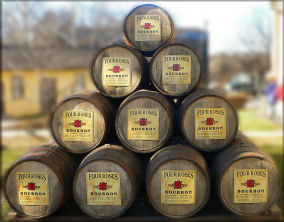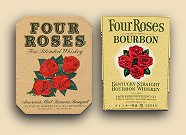American Whiskey
November
15,
2005:
A
Rose
is a
Rose
is a
Rose
is a
Rose
...
or maybe not
The Four Roses
Distillery |
|
Just a couple of miles south of Lawrenceburg, on
old Bond Mill Road, stands what may be one of America's most unusual
distilleries.
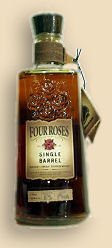
For one thing, although nearly a dozen straight bourbon whiskeys
are produced here, since the early 1940s none of them could be purchased in the United States. Four Roses Kentucky Straight Bourbon Whiskey has been among the most popular brands in the world (second only to Jim Beam, according to an article in Whisky Magazine) for over sixty years. But that's probably not the whiskey you're thinking of. If you didn't move to the United States from Asia or Europe, you've probably never tasted it. In fact, unless you're already on the good side of Social Security, your father probably never tasted it.
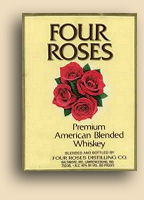
For another, the Four Roses whiskey which you ARE probably
thinking of, one of America's best-known and cherished brands during all that
time, is NOT made here, and never
was. In fact, it wasn't even bourbon. THAT Four Roses was a BLENDED whiskey,
meaning it was mostly neutral spirits (vodka) with only a
small amount of real whiskey added for flavor. And that was ONLY available in
the United States. Both were made by the Seagram's distilling company, but the
blended whiskey was made in other places, several of them in fact. Louisville,
Kentucky -- Baltimore, Maryland -- even ANOTHER Lawrenceburg (in Indiana). Only
the straight bourbon Four Roses has ever been made at this distillery (although
some of the whiskey made here might have been used in flavoring the blend). Until recently, the products of this distillery in Kentucky were mostly shipped
in bulk to Scotland and bottled there.
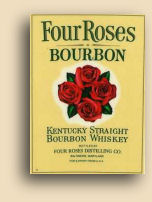
Confused? Well, here's how such a remarkable situation came to be...
Four Roses is a brand of American whiskey that has been around since the 1860's. At some time in the colorful life of this brand, a story began about how the brand got its name. It is a romantic tale, and as happens with romantic tales the world over, it has become embellished
with the passing of the decades. In fact it has split up into at least three different stories that we know of.
The first concerns Rufus M. Rose, who was, in fact, the founder of the original
distillery. The story goes that he imagined creating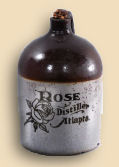 a brand name for his whiskey. That was somewhat of a novel idea prior to the war
between the states. But he had a bit of a head start anyway, because his
whiskey, of course, would already have been known as Rose's Whiskey. So the
thought of using a rose (the flower) as a trademark comes pretty easily.
However, he hadn't made a firm decision yet. Now, the distiller's family
frequently entertained by holding formal balls at their home, and for one of
these events either he or Mrs. Rose suggested that each of his four daughters
pick roses for their corsages from the garden. According to the story, when all
four appeared at the top of the stairway, Papa was so proud he decided right
there and then to name his new brand, the Four Roses. And so it came to be...
a brand name for his whiskey. That was somewhat of a novel idea prior to the war
between the states. But he had a bit of a head start anyway, because his
whiskey, of course, would already have been known as Rose's Whiskey. So the
thought of using a rose (the flower) as a trademark comes pretty easily.
However, he hadn't made a firm decision yet. Now, the distiller's family
frequently entertained by holding formal balls at their home, and for one of
these events either he or Mrs. Rose suggested that each of his four daughters
pick roses for their corsages from the garden. According to the story, when all
four appeared at the top of the stairway, Papa was so proud he decided right
there and then to name his new brand, the Four Roses. And so it came to be...
Nice story. Makes sense, too.
Except that Rufus Mathewson Rose of Atlanta, founder and operator of the R. M. Rose & Co. Distillery of Vining, Georgia,
and a prominent figure in post-Reconstruction Atlanta society, was just about three
daughters short of the alleged four.
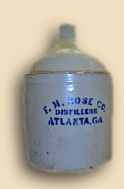
He did have a son, however. Randolph Rose, who, along with his uncle and cousin, was also involved with the distillery. But we'll get to that a little bit later.
One can only imagine how successful the brand might have been, had the garden contained only chrysanthemums or snap-dragons.
Okay, the next version of the story is neither more nor less likely, but it has some nice romantic elements to it. It involves a young man (whose identity varies with the storyteller) who is smitten by a young lady, daughter of a wealthy family. Because he is shy and can't bear to hear her immediate answer, he proposes marriage remotely, by way of a letter, . There is an upcoming grand ball (a recurring theme in these stories) at which they will both be in attendance, and he begs her to answer by wearing a corsage of four red roses if she accepts.
And here the story breaks into
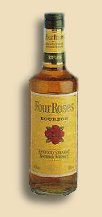 two completely opposite endings. In
the earlier of the two, she rejects him. His emotions crushed, the young man
vows never to love again. When he later becomes a distillery owner, he creates a
whiskey that is ever-faithful, enduring, and constant. One that would never let
you down. And he names that whiskey Four Roses in memory of his failed love.
two completely opposite endings. In
the earlier of the two, she rejects him. His emotions crushed, the young man
vows never to love again. When he later becomes a distillery owner, he creates a
whiskey that is ever-faithful, enduring, and constant. One that would never let
you down. And he names that whiskey Four Roses in memory of his failed love.
The other ending, and it is this version which is the one currently told by the company, is just the opposite. In this one, the suitor asks the object of his affections to signal her acceptance with a corsage containing a single red rose, and the young lady, in a display of exuberance reminiscent of "Tie a Yellow Ribbon 'Round the Old Oak Tree", appears wearing a corsage containing not one, but FOUR red roses as her very affirmative answer. We suspect they lived happily ever after, and named their first-born whiskey brand after the event.
Rufus M. Rose, the distillery owner in the first story, really did exist. And so did the young man in the other two stories. He is said to have been Paul Jones, whose Frankfort Distillers marketed the Four Roses brand from the end of Prohibition until he sold it to Seagram's in 1941.
That would have been the post-Repeal Seagram's of Samuel Bronfman, not the pre-Prohibition Seagram's operated by Joseph E. Seagram himself. According to those who believe Four Roses to be Rufus Rose's whiskey, they sold the brand to Joseph Seagram's in 1913.
I know. This isn't doing anything to clear up your confusion, is it?
The official company version holds that the young suitor was Paul L. Jones, Jr., who would later become one of the most important figures in the history of American whiskey. It's certainly possible; Paul Jones was indeed a young and single Atlanta whiskeyman at the time Rufus Rose was proudly showing off his (one and only) daughter at formal balls, and there could be a basis for the story. Except that, if it really were Paul Jones, then it would be the first ending mostly likely to have occurred, since Paul Jones actually never did marry. However, we were not able to find any corroborating information about him pining his life away over his lost love.
In reality, the most likely story of all, and the one we tend to believe, is bit more mundane. The fact is that the R. M. Rose Distilling Company of Atlanta and Chattanooga was owned and operated through two generations by Rufus M. Rose, his brother Origen Rose, and their two sons. Those would, of course, have been the "four Roses". But of course the stories are nice, too.
Then, again, we may not have heard all there is to learn about this, even yet. Stay tuned...
Rufus Rose's distillery in Vining, which was also known as
Mountain Spring Distilling Company, was very successful, but Georgia voted for
state prohibition to commence January 1, 1908, so in 1907 the distillery was
moved about 100 miles to Chattanooga, Tennessee. Okay, so perhaps just a little more foresight
might have led them to consider a different state, seeing as how Tennessee also went dry less than two years later,
but these things happen. Anyway, the Roses began marketing their whiskey brands
from their new general offices in Chattanooga. And they continued to
do so until selling the company in 1913.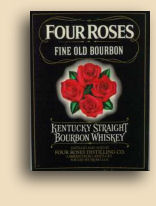
Before, or possibly after, they left Georgia, it appears that Paul Jones became involved with the company, although not everyone agrees on that. At least one source indicates a relationship lasting for over two decades.
And this is where the story begins to get even weirder...
According to the City of Atlanta, the FOUR ROSES brand was first registered as a trademark in 1906, which would have been immediately before the distillery moved to Tennessee. We have also heard that it was registered by Paul Jones, not by R. M. Rose & Company. Kirin/Seagram's official history of the brand says it was registered by Paul Jones in 1888, four years after he had moved his operations to "Distillers' Row" in Louisville. Jones claimed to have been selling whiskey under the Four Roses name since the 1860s. Stuart Ramsay, in an issue 34 article of Whiskey Magazine, adds that was "after he had acquired the rights to a whiskey brand owned by a Tennessee family named Rose."
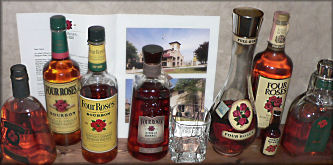 All of which would lead us to conclude that there may have been two completely distinct distilleries in Atlanta using the unregistered name of Four Roses for their independent products. Or possibly the relationship between Paul Jones and Rufus Rose was simply the selling of that label to Jones sometime around 1888 so he could register and make it official.
All of which would lead us to conclude that there may have been two completely distinct distilleries in Atlanta using the unregistered name of Four Roses for their independent products. Or possibly the relationship between Paul Jones and Rufus Rose was simply the selling of that label to Jones sometime around 1888 so he could register and make it official.
That is, that WOULD lead us to that conclusion, except...
There was this article, published in the Atlanta Intown newspaper by Ann Taylor Boutwell, in which she quotes [Georgia] State Historic Preservation Office Staff Historian Kenneth H. Thomas, Jr., as saying, "There is no provable link between Rufus M. Rose, The R. M. Rose Company, and Four Roses distillery... The only provable link of Four Roses to Atlanta was through Paul Jones, who lived in Atlanta from Civil War times until prohibition in the 1880's [sic]. He moved to Louisville, Ky., where he marketed and trademarked Four Roses Bourbon." .
According to Sam K. Cecil (The Evolution of The Bourbon Whiskey
Industry in Kentucky, 1999, Turner, Paducah, KY) Paul Jones had a very close
link with Rufus Rose and the R. M. Rose Company -- for a period of maybe
twenty-four years he was a very successful whiskey salesman for that firm. Like
many of the people who have been a major influence in the history of American
whiskey, Jones was never important as a distiller (if, indeed, he ever was one),
but his contribution was from his role as a wholesale liquor dealer and distillery owner. And the
years he spent with Rose & Co. were the foundation for that success. He sold the
R. M. Rose brands mostly in Tennessee and Georgia.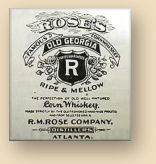
But about those brands...
The R. M. Rose Co. was no small-fry outfit. Rose himself was a prominent citizen and his company, which regularly advertised in newspapers and appeared in the annual Atlanta City Directory, prided itself on being "distillers and dealers of the oldest, richest and best wines, liquors and brandies". They also published and advertised their product names, which included Rose's Old Georgia Corn Whiskey, Roseís Mountain Dew, and Old Reserve Stock corn whiskeys, and Roseís Pure Peach and Virginia Apple brandies. They were also proud to be the sole distributors of Atlanta Spirit Rye. Presumably, these were all brands that Paul Jones was selling for them.
We could find no mention that they marketed a brand named "Four Roses".
In the early 1880s, Paul Jones moved to Louisville to establish
the Paul Jones & Company distributorship. He may have bought whiskey from R. M.
Rose & Company; 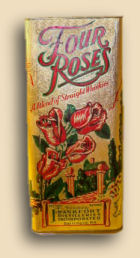 Sam
Cecil and others say that he bought the brand itself (although R. M. Rose & Co.
never indicated there was such a brand to buy). However, Cecil then goes on to
say that between his arrival in Louisville and 1890, when he and his son
Saunders P. (Paul?) Jones began operating the
J. G. Mattingly & Sons distillery, the brand he was selling was called "Jones
Four Star Whiskey".
Sam
Cecil and others say that he bought the brand itself (although R. M. Rose & Co.
never indicated there was such a brand to buy). However, Cecil then goes on to
say that between his arrival in Louisville and 1890, when he and his son
Saunders P. (Paul?) Jones began operating the
J. G. Mattingly & Sons distillery, the brand he was selling was called "Jones
Four Star Whiskey".
In fact, there doesn't appear to be any evidence that Paul L. Jones, Jr. ever used, or even ever heard of, the name Four Roses. By 1925, thirty years after his death, the wholesale company that bore his name had accumulated thousands of barrels of whiskey throughout Kentucky, Pennsylvania, and Maryland. In that year they were required to move all of their stock to the Frankfort Distillery, a designated concentration warehouse and bottler, which bottled it for medicinal purposes under several brands, including those which the distillery itself owned. Among the brands bottled was Four Roses. The Frankfort Distillery didn't even last through Prohibition; by 1928 all of the stock had been sold and the plant was closed. The Paul Jones Company bought the name and all the distillery's brands (which would have included Four Roses), and the Frankfort Distilleries (located in Louisville where Jones' offices were) went on to become the post-Repeal empire that lasted until the fifties. And whose Four Roses brand was sold to Joseph E. Seagram & Sons in 1941.
That would have been Samuel Bronfman's Joseph E. Seagram & Sons. His company, Distillers Corporation, Ltd., began using that name after they bought it in 1928.
If you follow the R. M. Rose version, the Four Roses brand was sold by them to the Joseph E. Seagram & Sons Company in 1913. This would have been the original Seagram's. As far as we can figure out (and, yes, the logic has holes in it... more study is needed... send funds now!) that Seagram's had sold the brand to the Frankfort Distillery, which was later purchased by Paul Jones. Or rather, by the company operating under Paul L. Jones, Jr.'s name.
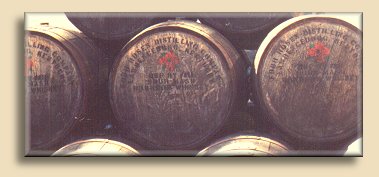
Of course, if you accept the official story that has Paul Jones the registered owner of the brand since 1888, that would hardly have been necessary. But that's how it goes, trying to figure out just what really happened to who in the fascinating whiskey industry. Because of the way the names change independently of the actual business, brands, products, and so forth, you can find support for several different versions of what really occurred. In this case, either the original Roses sold the Four Roses brand to the original Seagram, who then sold it to the original Frankfort Distillery, or Paul Jones' company, operating as the Frankfort Distillery, sold it to Sam Bronfman's company, operating as Seagram. All you can do is smile, and pour another glass of bourbon.
And whether the original Seagram's company owned Four Roses going into Prohibition, or whether its similarly-named successor purchased it from Paul Jones' renamed company along the way, or both, the "new" Seagram's ended up owning the brand, the stock, and the distillery at the beginning of the second World War.
Distilleries, actually. Paul Jones' Frankfort Distilleries was an
empire of plants in many different locations. This is only one of them; and in
fact, it has quite a rich history of its own.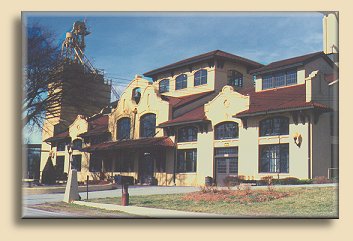
It was built in the early 1900ís to resemble the architecture of Southern California wineries, and it looks like nothing so much as a Spanish mission, complete with arches, red tiled roofs and even a bell tower. And it was originally known as the Old Prentice distillery; locals still often call it by that name. The distillery was built by Creel Brown to replace the plant his father, J.T.S. Brown, had operated across the street, where they made a bourbon called Old Joe. In fact, the present distillery is also called Old Joe sometimes.
Besides making the whiskey which will forever be known as Fast Eddie Felson's
whiskey-of-choice in the classic movie, "The Hustler", John Thompson Street
(J.T.S.) Brown has the distinction of being the founder of one of the most
important lines of American whiskeymakers, which would include the Browns
(Brown-Forman; Jack Daniel; Early Times; Old Forester; Woodford Reserve), the
Thompsons (Glenmore; Yellowstone), and the Streets (like the Beams, nearly
everywhere). Not to mention the Ripy brothers, who were the dominant family in
this area at the time and who operated several distilleries here.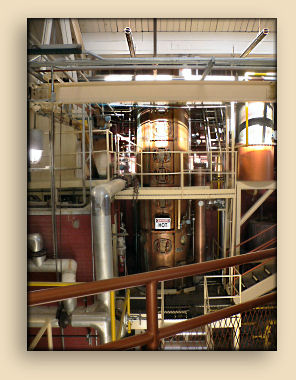
"Old Joe" has the distinction of being America's first known "brand" of bourbon, having been made by Joseph Peyton from around 1818 to 1840 at yet another distillery whose ruins can also be seen nearby. The brand name also adorned whiskey produced at this facility shortly after the end of Prohibition, when Frankfort Distillers Corporation bought the building. They later abandoned that brand and moved their Four Roses operations here from its original location in the Louisville suburb of Shively. They sold it (along with the rest of Frankfort Distillers) to Seagram's in 1941.
In 2001, Seagram's itself was purchased by another world-class conglomerate,
Vivendi, who was interested only in the entertainment properties and re-sold the
liquor businesses. Diageo, the largest liquor company in the world, bought the
Seagram's liquor brands, kept some, and put the rest up for sale. Four Roses was
included. The Japanese brewing giant, Kirin, had been the distributor for Four
Roses throughout Asia, and Four Roses was the best-selling American whiskey.
They didn't want to lose the product, so they bought it. Acc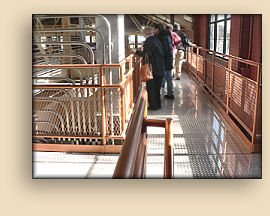 ording
to everyone we've spoken to at Four Roses, this has become a win-win-win-win-win
situation for all concerned. And that most certainly includes Americans who
enjoy the unique qualities of this fine bourbon, as well as those who carefully
craft it.
ording
to everyone we've spoken to at Four Roses, this has become a win-win-win-win-win
situation for all concerned. And that most certainly includes Americans who
enjoy the unique qualities of this fine bourbon, as well as those who carefully
craft it.
Because, you see, one other thing that makes Four Roses Kentucky
Straight Bourbon unique is the way the whiskey itself is made. In their
advertising, on their web page (http://www.fourroses.us/main.php),
and their conversation, the people who make whiskey here stress their
passion for what they do. That's a good word, "passion". A word that,
like "quality", tends to get misused by corporate marketing departments, but one
which accurately describes the feeling for this craft that we can see on the
faces of those who do it. It's not limited to the Four Roses Distillery, of
course; this passion is what has always attracted us to American whiskeymakers,
regardless of what company they work for.
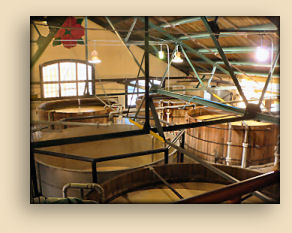 It
shows in the way they interact with one another as both competitors and close
friends. You see it in sports teams, and whiskey distillers, and a handful of
other professions. And the publicist who picked it to describe the Four Roses
team in their video presentation and their web site chose wisely. The passion
can be seen in everything they do here.
It
shows in the way they interact with one another as both competitors and close
friends. You see it in sports teams, and whiskey distillers, and a handful of
other professions. And the publicist who picked it to describe the Four Roses
team in their video presentation and their web site chose wisely. The passion
can be seen in everything they do here.
Four Roses Straight Bourbon is made very differently from other bourbon whiskeys, which are usually the result of distilling a particular kind of whiskey and then picking from among the aged barrels to achieve a consistent and identifiable flavor profile. At most American distilleries, there is only one, or perhaps two, recipes (called mashbills) and usually only one strain of yeast. All the basic whiskey is made pretty much the same. The differences, and they can be quite dramatic, come in the way the bourbon is allowed to mature. And combining these different styles of what is essentially the same basic whiskey is how the different characteristics are maintained. When Seagram began producing Four Roses bourbon, they made it in much the same way they made blended Scotch, from several different types, each from a distiller specializing in that particular style. Except that here all of the different kinds of bourbon are made by the same distillery.
When the Kirin company took over the brand and the production
facilities, they made no plans to change anything at all. It was already a huge
success and there was no need to mess around with it. The distillers and the
staff that was here still are, and they have as much or more say in how the
bourbon is made than they did before.
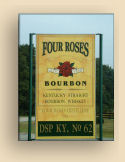 Master distiller Jim Rutledge works with
two distinct mash bills and five varieties of yeast. That allows him to create
up to ten completely different types of bourbon whiskey, using the different
combinations of grain and yeasts, as well as different processing times and
temperatures, and so forth.
Master distiller Jim Rutledge works with
two distinct mash bills and five varieties of yeast. That allows him to create
up to ten completely different types of bourbon whiskey, using the different
combinations of grain and yeasts, as well as different processing times and
temperatures, and so forth.
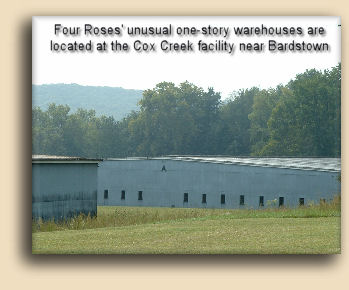 With the exception of the single-barrel offerings,
none of these will ever be released as a standalone product; they are all made
to be mingled together to create one of the several styles of Four Roses
bourbon.
With the exception of the single-barrel offerings,
none of these will ever be released as a standalone product; they are all made
to be mingled together to create one of the several styles of Four Roses
bourbon.
Four Roses bourbon is also aged differently. American whiskey,
especially Kentucky bourbon, is traditionally aged in very tall warehouses.
Eight stories is common. The idea is to take advantage of the wide variation in
temperature that exists between the top and lower floors, and between the inner
areas and near the outer walls. Four Roses ages their whiskey in low, one-story
warehouses made especially to ensure that each barrel has as close to the exact
same environment as possible. The warehouses are not at the distillery; they're
located in Bullitt county, about fifty miles away.
When we first visited this distillery, in early 1999, Seagramís
wasn't offering scheduled public tours. And in fact, until recently there were
still no regular public tours here. But that's changed now. Not only is Four Roses open and available for public
tours, they have put in significant upgrades in appearance and accessibility and
made the environment very public-friendly. The result is that the Four Roses
distillery has now become a "don't miss this one" for any person interested in
distillery tours. It also has something to offer that you'll find nowhere else.
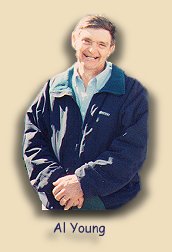 Unless you already live in or near Kentucky, you can't buy
100-proof, single-barrel Four Roses Straight Bourbon. It isn't sold in the other
49 United States yet, and it's not the same as the single-barrel Four Roses
you'll find in Europe or Asia. You can buy it at the distillery, and you can
taste a small sample of it there, too.
Unless you already live in or near Kentucky, you can't buy
100-proof, single-barrel Four Roses Straight Bourbon. It isn't sold in the other
49 United States yet, and it's not the same as the single-barrel Four Roses
you'll find in Europe or Asia. You can buy it at the distillery, and you can
taste a small sample of it there, too.
There's another wonderful feature, unique to the Four Roses tour, that we are happy to see is still here. When we visited the first time, we were taken around by the operations and training supervisor, a gentleman whose very comprehensive tour was intended for a more knowledgeable audience of in-house sales and marketing representatives. His name is Al Young, and we are delighted that he is still here. He's manager of distillery operations now, and we're not sure if he still gives tours regularly, but Al's the nicest guy you're ever likely to meet and he loves every aspect of making whiskey passionately. If you're interested in really learning just how they do it, and if you're lucky enough to be there when Al Young's around, he'll give you a distillery tour you won't forget.
Alís tour begins where the whiskey begins, in the tiny but
vitally important room where the grain is inspected. He explains the importance
of quality and he'll let you sniff from a jar of unacceptable corn so you can
learn first hand what "off" flavors smell like. Corn is the major
ingredient in bourbon, and Four Roses is very particular about its quality. Al
tells us that the corn they use comes from the same growers in Indiana that
they've worked with for decades. That doesn't mean they'll hesitate to reject a
shipment if it doesn't meet their standards; and although it's not common,
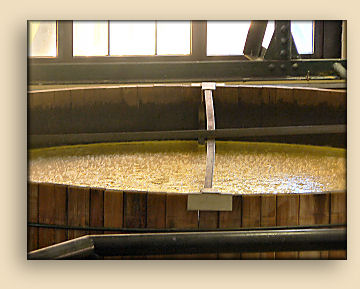 Al
says that does happen every once in awhile. He then takes us through the rooms
where the milling takes place and into the main part of the production area. He
shows us the control room and how nearly every detail of the process is
monitored and controlled, using computer technology Ė levels, temperatures,
speeds, volumes, everything.
Al
says that does happen every once in awhile. He then takes us through the rooms
where the milling takes place and into the main part of the production area. He
shows us the control room and how nearly every detail of the process is
monitored and controlled, using computer technology Ė levels, temperatures,
speeds, volumes, everything.
We then walk around to the fermenting tanks (ancient and brand-new cypress, as well as stainless steel), the cookers, the beer still itself, and the doubler, which is really a big copper pot still used for the second distillation.
Al shows some things on this tour that you're not likely to have seen before,
such as the "dona room" where tanks of live yeast is grown. Not all distilleries use
this method, and those that do are usually not too keen to take visitors
there. And at the tailbox we had a chance to taste a sample of 132 proof "white dog" as
it comes out of the still.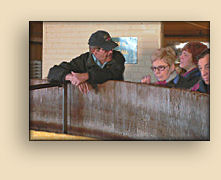
Al is one of the most knowledgeable hosts we've ever known. And
one of the most open and straightforward. There is not a hint of the "memorized
presentation" or condescension to the visitors that we've noticed occasionally
at other distilleries. As it happens, all of people in the group visiting today
are pretty familiar with bourbon whiskey, and one member notes that, regardless
of how many different combinations of yeasts and mashbills they may have to work
with, their premium product (at least in the United States) is single-barrel,
that is, all of the whiskey in a given bottle will have been aged in the same
single barrel. That brought up the question of whether there is a particular
combination (for example, mash#2 and yeast #5) that is used consistently in
making the single-barrel bourbon.
Al also happens to be an absolute master at making that fine distinction between
those things that can help an enthusiast to understand better, and those which
need to be kept proprietary. On distillery tours (or probably any other public
tour of a company plant site) questions such as the one above, or whether the
company plans to introduce further brands in the near future, are not uncommon.
More often than not, they're "answered" with empty, press-release phrases ("We're
proud to maintain dependable consistency through cutting-edge innovation"), or
prefabricated fiction ("Yes, bourbon whiskey was invented by Our Founder
shortly after arriving in Kentucky, carrying
only his pot still and a bologna sandwich, along with a few accidentally charred
new oak barrels. "). Al manages to answer questions
such as these honestly and with all the appropriate information, while making it
clear that some things just have to remain trade secrets. Things like, "what's
the secret recipe for your single-barrel whiskey?" for example.
It's all just part of the passion.
